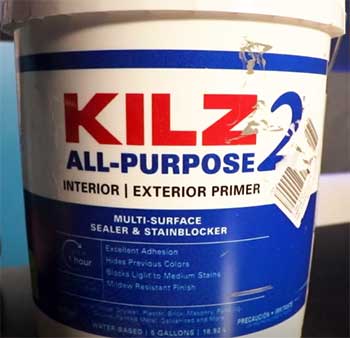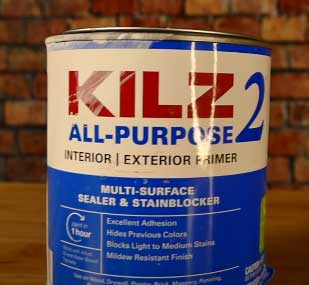I’ll admit it—I’m no stranger to a paintbrush. Over the years, I’ve tackled everything from stubborn water stains to outdated paneling, always chasing that flawless finish. So when I grabbed a can of Kilz 2 primer, I thought I’d found my trusty sidekick.
Known for its affordability and versatility, it’s marketed as a solid choice for prepping walls, wood, and more. But here’s the thing: my experience didn’t quite match the hype. From bleed-through disasters to peeling nightmares, Kilz 2 let me down in ways I didn’t expect.
In this article, I’m spilling the beans on the real problems I—and others—have faced with Kilz 2 primer. My goal? To walk you through each issue with a clear, no-nonsense breakdown, share some alternatives worth considering, and leave you better equipped for your next painting project.
Let’s get into it.
Quick List of Kilz 2 Primer Problems
Right off the bat, here are the headaches I encountered with Kilz 2:
- Persistent bleed-through from stains and knots.
- Peeling and adhesion issues on certain surfaces.
- Poor coverage over bold colors or stains.
- Confusion over its intended use and limitations.
- Speckled stains showing up after painting.
Now, let me break these down one by one with the kind of detail that’ll make you feel like you’re right there with me, roller in hand.
Persistent Bleed-Through: The Stain That Won’t Quit

I’ve always relied on primers to lock away ugly stains—watermarks, wood knots, you name it.
With Kilz 2, I figured I’d slap on a coat or two and call it a day.
Nope.
I was painting over some old paneling in my basement, the kind with dark knots that scream 1970s vibes.
After one coat dried (a full 24 hours, mind you), those knots peeked through like uninvited guests.
Two coats? Still there.
Three coats?
You guessed it—bleed-through city. Each layer took about three hours to apply, plus drying time, turning a weekend project into a two-week saga. I couldn’t believe it. This wasn’t some heavy ink or grease stain; it was just wood grain fighting back harder than Kilz 2 could handle.
The promise of “stain-blocking” on the can felt like a stretch. I started wondering if I’d grabbed the wrong product. Turns out, Kilz 2, being a latex-based primer, doesn’t pack the same punch as its oil-based cousins when it comes to sealing tough stains.
If you’re facing water stains on a ceiling or knots in pine shelves, you might find yourself in the same boat—layering on coat after coat, watching your patience (and paint budget) dry up.
Peeling and Adhesion Woes: When Primer Plays Hard to Get
Next up, let’s talk about adhesion—or the lack of it. I decided to use Kilz 2 on some fresh drywall in my guest room, thinking it’d be a breeze.
The walls were smooth, the primer went on evenly, and I was feeling pretty good about it. Fast forward to painting day: I rolled on my topcoat, and within hours, I noticed tiny bubbles forming.
Then came the peeling. It wasn’t dramatic, Hollywood-style flaking, but enough to make me groan. I scraped a fingernail across it, and sure enough, the primer lifted right off like a bad sunburn.
I’ve since learned Kilz 2 doesn’t always bond well with certain surfaces—fresh drywall, glossy old paint, or anything too slick. The label says it’s great for wood or brick, but throw it on something less porous, and it’s like trying to stick a Post-it to a Teflon pan.
I wish I’d sanded those surfaces first or picked a primer designed for trickier jobs. Lesson learned: Kilz 2 isn’t the universal glue I hoped it’d be.
Poor Coverage: When Colors and Stains Fight Back

Coverage is where I really started to question my loyalty to Kilz 2. I had a living room with medium-green walls I wanted to transform into a soft gray.
Easy, right?
Not so much. After one coat of Kilz 2, I could still see a faint green tint lurking beneath.
Two coats later, it was better but not gone.
Three coats, and I was ready to wave a white flag. The same thing happened with some trim that had a light brown stain—three coats, and it still yellowed through like a stubborn ghost.
This isn’t about me skimping on effort; I applied thick, even layers and gave each one plenty of dry time. Kilz 2 just couldn’t muscle past those bolder tones or lingering marks. It’s marketed as a “multi-surface” primer, but it seems better suited for neutral bases than anything with personality.
If you’re covering up a pastel wall, you might be fine. Tackling something darker or stained? You’ll need more elbow grease—and probably a different product.
Confusion Over Use: A Labeling Letdown
Here’s where I got tripped up big time: figuring out what Kilz 2 is actually for. I grabbed a can off the shelf, saw the familiar Kilz name, and assumed it’d handle my usual suspects—water stains, knots, the works.
I’d used original Kilz oil-based primer before and loved it, so I thought Kilz 2 would be a slick latex upgrade. Wrong. After my bleed-through fiasco, I dug into the fine print and realized Kilz 2 is more of a basic primer, not a heavy-duty stain-blocker like Kilz Max or the oil-based version.
The packaging didn’t scream that difference loud enough for me. I’m not alone here—plenty of folks pick it up expecting miracles, only to find it’s not built for the toughest jobs.
A clearer label or an in-store guide could’ve saved me a trip back to the hardware store, quart in hand, grumbling about wasted time. If you’re new to priming, this mix-up can throw you for a loop.
Speckled Stains: The Surprise No One Wants

This one hit me out of nowhere. I hired a contractor to prep my kitchen and living room ceilings with Kilz 2 before painting.
The living room turned out fine—smooth, clean, ready for color.
The kitchen?
A disaster. After two coats of paint went up, I started noticing brown speckles bleeding through.
At first, I thought it was dirt or splatter, but no—these were stains from who-knows-what, pushing past the primer like tiny polka dots of defeat. I was crushed. Now I’m staring down another round of painting, and my trust in Kilz 2 is officially shaken.
It’s not just me—others have reported similar speckling surprises, especially in high-moisture spots like kitchens. Kilz 2 might work on dry, tame surfaces, but throw in some hidden stains or humidity, and it’s like the primer just gives up. I should’ve tested a small patch first, but hindsight’s 20/20, right?
Alternatives To Kilz 2 Primer
Before I wrap up with some FAQs, let’s talk options. Kilz 2 isn’t a total dud—it’s cheap and decent for basic jobs—but if you’re hitting the same snags I did, here are four alternatives worth a look:
- Kilz Original Oil-Based Primer – The OG stain-blocker. It’s messier and smells stronger, but it seals knots and water stains like a champ.
- Kilz Max – A water-based upgrade for indoor use. Better at locking in tough stains without the oil-based hassle.
- Zinsser BIN Shellac-Based Primer – Pricey, but it sticks to anything and blocks bleed-through like nobody’s business.
- Zinsser 1-2-3 Plus – Great for adhesion on slick surfaces and decent stain-blocking, all in a low-odor formula.
Each one’s got its quirks, but they’ve saved my bacon on projects where Kilz 2 fell short. Pick based on your surface and stain situation—you won’t regret it.
Frequently Asked Questions (FAQ)
Ventilate the room, wear a mask if fumes bug you, and keep it off your skin. It’s latex-based, so cleanup’s easy with soap and water, but don’t slack on safety.
One or two should do for basic jobs, but tough stains or colors might need three—or a stronger primer altogether.
It’s solid for light prep on wood or brick, but it struggles with stains and adhesion on tricky surfaces. Good, not great.
Check for a funky smell, clumpy texture, or separation that won’t mix back in. If it’s off, toss it.
Wrapping Up
Looking back, my journey with Kilz 2 primer was a rollercoaster of hope and frustration. I wanted a quick fix for stains, colors, and quirky surfaces, but I got bleed-through, peeling, and a hard lesson in reading labels.
It’s not a bad product—its affordability and ease of use have their charm—but it’s not the superhero I expected. You’ve got my rundown now: the pitfalls, the workarounds, and a few alternatives to keep in your back pocket.
Next time you’re staring down a painting project, you’ll know what to watch for. Grab the right tool for the job, and you’ll save yourself the headaches I waded through. Happy painting!
